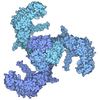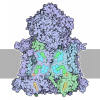+ Open data
Open data
- Basic information
Basic information
| Entry | Database: PDB / ID: 8ixn | ||||||||||||||||||
|---|---|---|---|---|---|---|---|---|---|---|---|---|---|---|---|---|---|---|---|
| Title | Curved structure of mPIEZO1-S2472E | ||||||||||||||||||
 Components Components | Piezo-type mechanosensitive ion channel component 1 | ||||||||||||||||||
 Keywords Keywords | MEMBRANE PROTEIN / Closed-state structure / PIEZO1 channel | ||||||||||||||||||
| Function / homology |  Function and homology information Function and homology informationmechanosensitive monoatomic cation channel activity / cuticular plate / positive regulation of cell-cell adhesion mediated by integrin / detection of mechanical stimulus / positive regulation of integrin activation / mechanosensitive monoatomic ion channel activity / stereocilium / positive regulation of myotube differentiation / monoatomic cation transport / lamellipodium membrane ...mechanosensitive monoatomic cation channel activity / cuticular plate / positive regulation of cell-cell adhesion mediated by integrin / detection of mechanical stimulus / positive regulation of integrin activation / mechanosensitive monoatomic ion channel activity / stereocilium / positive regulation of myotube differentiation / monoatomic cation transport / lamellipodium membrane / monoatomic cation channel activity / endoplasmic reticulum-Golgi intermediate compartment membrane / regulation of membrane potential / endoplasmic reticulum membrane / endoplasmic reticulum / identical protein binding / plasma membrane Similarity search - Function | ||||||||||||||||||
| Biological species |  | ||||||||||||||||||
| Method | ELECTRON MICROSCOPY / single particle reconstruction / cryo EM / Resolution: 4.07 Å | ||||||||||||||||||
 Authors Authors | Liu, S. / Yang, X. / Chen, X. / Li, X. / Xiao, B. | ||||||||||||||||||
| Funding support |  China, 5items China, 5items
| ||||||||||||||||||
 Citation Citation |  Journal: Neuron / Year: 2024 Journal: Neuron / Year: 2024Title: An intermediate open structure reveals the gating transition of the mechanically activated PIEZO1 channel. Authors: Sijia Liu / Xuzhong Yang / Xudong Chen / Xiaochun Zhang / Jinghui Jiang / Jingyi Yuan / Wenhao Liu / Li Wang / Heng Zhou / Kun Wu / Boxue Tian / Xueming Li / Bailong Xiao /  Abstract: PIEZO1 is a mechanically activated cation channel that undergoes force-induced activation and inactivation. However, its distinct structural states remain undefined. Here, we employed an open-prone ...PIEZO1 is a mechanically activated cation channel that undergoes force-induced activation and inactivation. However, its distinct structural states remain undefined. Here, we employed an open-prone PIEZO1-S2472E mutant to capture an intermediate open structure. Compared with the curved and flattened structures of PIEZO1, the S2472E-Intermediate structure displays partially flattened blades, a downward and rotational motion of the top cap, and a spring-like compression of the linker connecting the cap to the pore-lining inner helix. These conformational changes open the cap gate and the hydrophobic transmembrane gate, whereas the intracellular lateral plug gate remains closed. The flattened structure of PIEZO1 with an up-state cap and closed cap gate might represent an inactivated state. Molecular dynamics (MD) simulations of ion conduction support the closed, intermediate open, and inactivated structural states. Mutagenesis and electrophysiological studies identified key domains and residues critical for the mechanical activation of PIEZO1. These studies collectively define the distinct structural states and gating transitions of PIEZO1. | ||||||||||||||||||
| History |
|
- Structure visualization
Structure visualization
| Structure viewer | Molecule:  Molmil Molmil Jmol/JSmol Jmol/JSmol |
|---|
- Downloads & links
Downloads & links
- Download
Download
| PDBx/mmCIF format |  8ixn.cif.gz 8ixn.cif.gz | 755.6 KB | Display |  PDBx/mmCIF format PDBx/mmCIF format |
|---|---|---|---|---|
| PDB format |  pdb8ixn.ent.gz pdb8ixn.ent.gz | 564.7 KB | Display |  PDB format PDB format |
| PDBx/mmJSON format |  8ixn.json.gz 8ixn.json.gz | Tree view |  PDBx/mmJSON format PDBx/mmJSON format | |
| Others |  Other downloads Other downloads |
-Validation report
| Summary document |  8ixn_validation.pdf.gz 8ixn_validation.pdf.gz | 1.5 MB | Display |  wwPDB validaton report wwPDB validaton report |
|---|---|---|---|---|
| Full document |  8ixn_full_validation.pdf.gz 8ixn_full_validation.pdf.gz | 1.6 MB | Display | |
| Data in XML |  8ixn_validation.xml.gz 8ixn_validation.xml.gz | 126.3 KB | Display | |
| Data in CIF |  8ixn_validation.cif.gz 8ixn_validation.cif.gz | 181.2 KB | Display | |
| Arichive directory |  https://data.pdbj.org/pub/pdb/validation_reports/ix/8ixn https://data.pdbj.org/pub/pdb/validation_reports/ix/8ixn ftp://data.pdbj.org/pub/pdb/validation_reports/ix/8ixn ftp://data.pdbj.org/pub/pdb/validation_reports/ix/8ixn | HTTPS FTP |
-Related structure data
| Related structure data |  35799MC  8ixoC M: map data used to model this data C: citing same article ( |
|---|---|
| Similar structure data | Similarity search - Function & homology  F&H Search F&H Search |
- Links
Links
- Assembly
Assembly
| Deposited unit | 
|
|---|---|
| 1 |
|
- Components
Components
| #1: Protein | Mass: 292362.688 Da / Num. of mol.: 3 / Mutation: S2472E Source method: isolated from a genetically manipulated source Source: (gene. exp.)   Homo sapiens (human) / References: UniProt: E2JF22 Homo sapiens (human) / References: UniProt: E2JF22#2: Chemical | ChemComp-PLX / ( #3: Chemical | #4: Chemical | Has ligand of interest | Y | Has protein modification | Y | |
|---|
-Experimental details
-Experiment
| Experiment | Method: ELECTRON MICROSCOPY |
|---|---|
| EM experiment | Aggregation state: PARTICLE / 3D reconstruction method: single particle reconstruction |
- Sample preparation
Sample preparation
| Component | Name: S2472E-Curved Structure / Type: COMPLEX / Entity ID: #1 / Source: RECOMBINANT |
|---|---|
| Source (natural) | Organism:  |
| Source (recombinant) | Organism:  Homo sapiens (human) Homo sapiens (human) |
| Buffer solution | pH: 7.3 |
| Specimen | Embedding applied: NO / Shadowing applied: NO / Staining applied: NO / Vitrification applied: YES |
| Vitrification | Cryogen name: ETHANE |
- Electron microscopy imaging
Electron microscopy imaging
| Experimental equipment |  Model: Titan Krios / Image courtesy: FEI Company |
|---|---|
| Microscopy | Model: FEI TITAN KRIOS |
| Electron gun | Electron source:  FIELD EMISSION GUN / Accelerating voltage: 300 kV / Illumination mode: FLOOD BEAM FIELD EMISSION GUN / Accelerating voltage: 300 kV / Illumination mode: FLOOD BEAM |
| Electron lens | Mode: BRIGHT FIELD / Nominal defocus max: 2300 nm / Nominal defocus min: 1500 nm |
| Image recording | Electron dose: 50 e/Å2 / Film or detector model: GATAN K3 BIOQUANTUM (6k x 4k) |
- Processing
Processing
| CTF correction | Type: NONE | ||||||||||||||||||||||||
|---|---|---|---|---|---|---|---|---|---|---|---|---|---|---|---|---|---|---|---|---|---|---|---|---|---|
| 3D reconstruction | Resolution: 4.07 Å / Resolution method: FSC 0.143 CUT-OFF / Num. of particles: 488709 / Symmetry type: POINT | ||||||||||||||||||||||||
| Refine LS restraints |
|
 Movie
Movie Controller
Controller





 PDBj
PDBj







